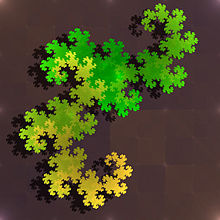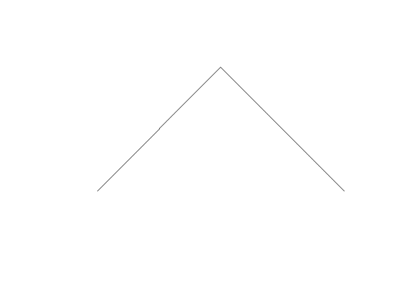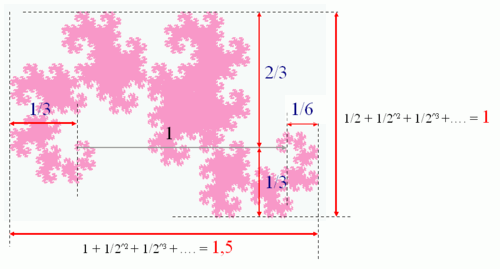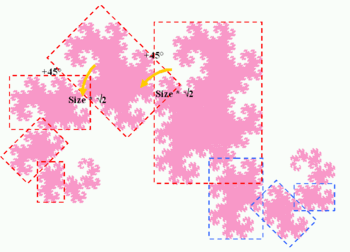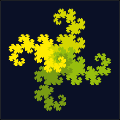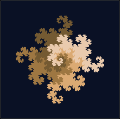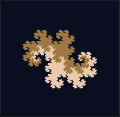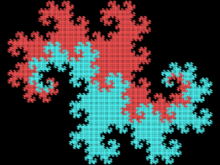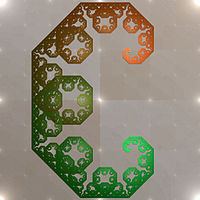- Dragon curve
-
A dragon curve is any member of a family of self-similar fractal curves, which can be approximated by recursive methods such as Lindenmayer systems.
Contents
Heighway dragon
The Heighway dragon (also known as the Harter–Heighway dragon or the Jurassic Park dragon) was first investigated by NASA physicists John Heighway, Bruce Banks, and William Harter. It was described by Martin Gardner in his Scientific American column Mathematical Games in 1967. Many of its properties were first published by Chandler Davis and Donald Knuth. It appeared on the section title pages of the Michael Crichton novel Jurassic Park.
Construction
It can be written as a Lindenmayer system with
- angle 90°
- initial string FX
- string rewriting rules
- X ↦ X+YF+
- Y ↦ −FX−Y.
That can be described this way : Starting from a base segment, replace each segment by 2 segments with a right angle and with a rotation of 45° alternatively to the right and to the left:
The Heighway dragon is also the limit set of the following iterated function system in the complex plane:
with the initial set of points S0 = {0,1}.
Using pairs of real numbers instead, this is the same as the two functions consisting of
This representation is more commonly used in software such as Apophysis.
[Un]Folding the Dragon
Tracing an iteration of the Heighway dragon curve from one end to the other, one encounters a series of 90 degree turns, some to the right and some to the left. For the first few iterations the sequence of right (R) and left (L) turns is as follows:
- 1st iteration: R
- 2nd iteration: R R L
- 3rd iteration: R R L R R L L
- 4th iteration: R R L R R L L R R R L L R L L.
This suggests the following pattern: each iteration is formed by taking the previous iteration, adding an R at the end, and then taking the original iteration again, flipping it, switching each letter and adding the result after the R.
This pattern in turn suggests the following method of creating models of iterations of the Heighway dragon curve by folding a strip of paper. Take a strip of paper and fold it in half to the right. Fold it in half again to the right. If the strip was opened out now, unbending each fold to become a 90 degree turn, the turn sequence would be RRL i.e. the second iteration of the Heighway dragon. Fold the strip in half again to the right, and the turn sequence of the unfolded strip is now RRLRRLL - the third iteration of the Heighway dragon. Continuing folding the strip in half to the right to create further iterations of the Heighway dragon (in practice, the strip becomes too thick to fold sharply after four or five iterations).
This pattern also gives a method for determining the direction of the nth turn in the turn sequence of a Heighway dragon iteration. First, express n in the form k2m where k is an odd number. The direction of the nth turn is determined by k mod 4 i.e. the remainder left when k is divided by 4. If k mod 4 is 1 then the nth turn is R; if k mod 4 is 3 then the nth turn is L.
For example, to determine the direction of turn 76376:
- 76376 = 9547 x 8.
- 9547 = 2386x4 + 3
- so 9547 mod 4 = 3
- so turn 76376 is L
There is a simple one line non-recursive method of implementing the above k mod 4 method of finding the turn direction in code. Treating turn n as a binary number, calculate the following boolean value:
- bool turn = (((n & −n) << 1) & n) != 0;
- "n & −n" leaves you with only one bit as a '1', the rightmost '1' in the binary expansion of n;
- "<< 1" shifts the that bit one bit to the left;
- "& n" leaves you with either that single bit (if k mod 4 = 3) or a zero (if k mod 4 = 1).
- so "bool turn = (((n & −n) << 1) & n) != 0" is TRUE if the nth turn is L; and is FALSE if the nth turn is R.
Gray code method
Another way of handling this is a reduction for the above algorithm. Using Gray code, starting from zero, determine the change to the next value. If the change is a 1 turn left, and if it is 0 turn right. Given a binary input, B, the corresponding gray code, G, is given by "G = B XOR (B>>1)". Using Gi and Gi−1, turn equals" (not Gi) AND Gi−1".
- G = B^(B >> 1); This gets gray code from binary.
- T = (~G0)&G1; If T is equal to 0 turn clockwise else turn counterclockwise.
Dimensions
- In spite of its strange aspect, the Heighway dragon curve has simple dimensions:
- Its surface is also quite simple : If the initial segment equals 1, then its surface equals
 . This result comes from its paving properties.
. This result comes from its paving properties. - Its boundary has an infinite length, since it increases by a factor of
 every iteration.[1]
every iteration.[1] - The curve never crosses itself.
- Many self-similarities can be seen in the Heighway dragon curve. The most obvious is the repetition of the same pattern tilted by 45° and with a reduction ratio of
 .
.
- Its fractal dimension can be calculated :
 . That makes it a space-filling curve.
. That makes it a space-filling curve.
- The fractal dimension of its boundary has been approximated numerically by Chang & Zhang.
In fact it can be found analytically [2]:
![\log_2\left(\frac{1+\sqrt[3]{73-6\sqrt{87}}+\sqrt[3]{73+6\sqrt{87}}}{3}\right)\cong 1.523627086202492.](9/0490d416e869bcf16706832fcea0f8d6.png) This is the root of the equation
This is the root of the equation 
Tiling
The dragon curve can tile the plane in many ways.
Twindragon
The twindragon (also known as the Davis-Knuth dragon) can be constructed by placing two Heighway dragon curves back-to-back. It is also the limit set of the following iterated function system:
where the initial shape is defined by the following set S0 = {0,1,1 − i}.
Terdragon
The terdragon can be written as a Lindenmayer system:
- angle 120°
- initial string F
- string rewriting rules
- F ↦ F+F−F.
It is the limit set of the following iterated function system:
- f1(z) = λz

- f3(z) = λz + λ *

Lévy dragon
The Lévy C curve is sometimes known as the Lévy dragon.
See also
- List of fractals by Hausdorff dimension
- Complex base systems
- Regular paperfolding sequence
Notes
- ^ http://library.thinkquest.org/26242/full/fm/fm8.html
- ^ "The Boundary of Periodic Iterated Function Systems" by Jarek Duda, The Wolfram Demonstrations Project. Recurrent construction of the boundary of dragon curve.
External links
Categories:- Fractal curves
- Paper folding
Wikimedia Foundation. 2010.


